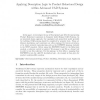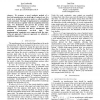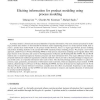1341 search results - page 2 / 269 » Logic for Modeling Product Structure |
DLOG
2003
13 years 6 months ago
2003
In this paper, we investigate the use of Description Logic (DL) for representing Product Behavioral constraints in Computer Aided Design (CAD) Systems. In an integrated design app...
DDECS
2009
IEEE
13 years 11 months ago
2009
IEEE
— We propose a novel synthesis method of a dual-rail asynchronous two-level logic of reduced cost. It is based on a model that operates under so called modified weak constraints....
DKE
2007
13 years 4 months ago
2007
A product model is a formal and structured definition of product information. The most common procedure for defining a product data model is to first describe the business and/...
ICSE
2007
IEEE-ACM
14 years 5 months ago
2007
IEEE-ACM
The essence of any modeling approach for product line architectures lies in its ability to express variability. Existing approaches do so by explicitly specifying variation points...
SPLC
2010
13 years 2 months ago
2010
Abstract. Feature modeling is a technique for capturing commonality and variability. Feature models symbolize a representation of the possible application configuration space, and ...



